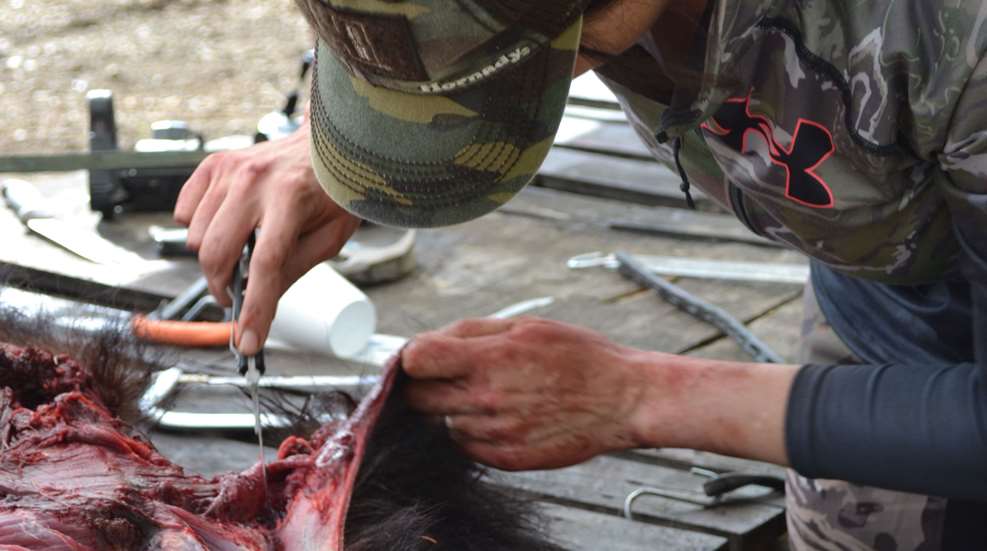
My dad is one of the most passionate hunters I know. Between himself and his kids, the man has skinned countless deer and turkeys and a few bears over the years—he’s a fast and effective skinner and butcher, at least as far as I knew. So imagine my surprise when I killed a deer on Dad’s property, went to skin it, asked to borrow a knife and found his collection of hunting knives in abysmal shape. The first one I picked up was rusty and dull. The second one I picked up was dull. The third one was dull and pitted. “Dad, what the heck?” I asked. “Why are these such a mess?”
He rooted through the pile, tossing knives aside, until he found one that was slightly less dull than the rest. “This is a good one,” he said. “Plenty sharp.”
Well, his definition of “sharp” and mine are apparently quite different, because I hacked and sawed with that knife and took twice as long butchering that buck as I normally would have.
The fact is, dull knives are terrible. They’re ineffective and downright dangerous, because they require more pressure in order to make cuts, and when you’re pressing too hard with a knife, it’s easy for it to slip and cut something it shouldn’t. “A sharp knife is a safe knife” is a cliché for a reason—it’s entirely true.
Sharpening knives isn’t hard. Sharpening them well, in my experience, is considerably harder, especially with some harder types of steel. I have a big fancy electric knife sharpener in my kitchen, but that does me no good in hunt camp or in the field, and I’ve never gotten good at using a whetstone. Replaceable-blade knives have taken all the work out of this for me, and if you haven’t tried one, you’re missing out.
They couldn’t be simpler: Install a blade, work until it gets dull, then discard it (many come with a safe little box to put old blades in) and install a new one. Swapping it out takes literally seconds, and you always have a scary-sharp knife without ever having to stop what you’re doing to sharpen a blade.
Early versions of these knives felt a little thinner and flimsier than I would like, but I adjusted to them quickly, and today, options abound. All the ones I’ve tried have been good. They come in several handle styles, and because the blades are generally pretty thin, they’re awesome for skinning and caping. This thinness does make the edge less durable than a traditional, thicker knife blade, so I recommend changing them often and not trying to use your replaceable-blade knife as, say, a prybar. Most of them are on the smaller and lighter side, so I put them away when it’s time to butcher and break out the fixed-blades, especially for the big-muscle deboning work.

Havalon is credited with starting this trend with their Piranta, which they still make, and now the company has expanded into other replaceable-blade styles, including some folders with a traditional blade on one end and a replaceable on the other. Tyto, Outdoor Edge, Gerber and many other companies all make great replaceable-blade knives.
What should you look for when shopping for a replaceable-blade hunting knife? Consider a few factors:
- Do you want a thin, scalpel-type blade or something a little heavier?
- Do you want a folder or a fixed-blade-style handle?
- How many blades come with the knife, and how expensive are extra packs of blades?
- How easy is it to change blades? Some are easier to swap out than others, and don’t forget, if you’re in the middle of skinning and caping, your hands will be slick. You want blades that change out easily so you don’t hurt yourself.
- Do you want a sheath? A pocket clip?
- Are different styles of blades available to fit the same handle?
- Does the handle accept blades from other brands? Many of the thin, scalpel-type knives do, but some brands are proprietary.
- If you go with a proprietary-blade style, are the blades disposable, or are they intended to be resharpened but swapped out with various styles for various jobs?
The bottom line: For skinning and caping, you want the sharpest knife possible to make the job faster and safer. Fixed-blade hunting knives are classic and will never go out of style. Replaceable-blade knife just don’t have the same cachet, but they make life much easier, and they’re almost always my first choice for skinning jobs. It’s just so incredibly handy to not have to stop what you’re doing and sharpen a knife. If you’re looking to buy one, decide if you want a scalpel-type blade or something sturdier and go with a trusted brand. Be careful swapping out blades (a multi-tool or needle-nose pliers makes it much safer), and always dispose of old blades safely.
After that box-of-dull-knives hunting season a decade ago, I bought Dad a fixed-blade Buck and a replaceable-blade Gerber knife for Christmas. He’s been using the Buck for years, but I am pretty sure that Gerber is still sitting in the knife box, unused. I still haven’t convinced him that sharper is better and replaceable is easier, but I’m working on it!














































